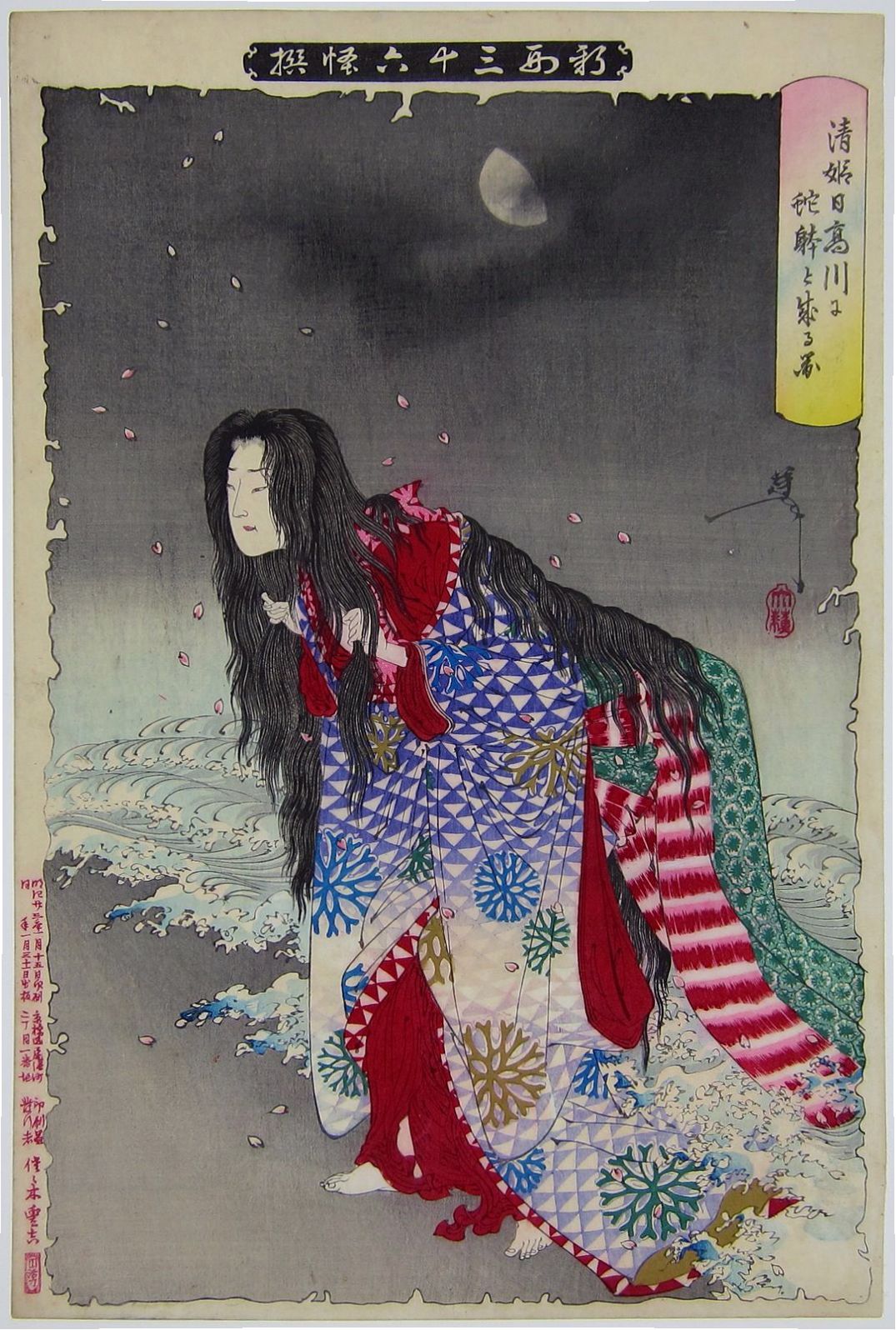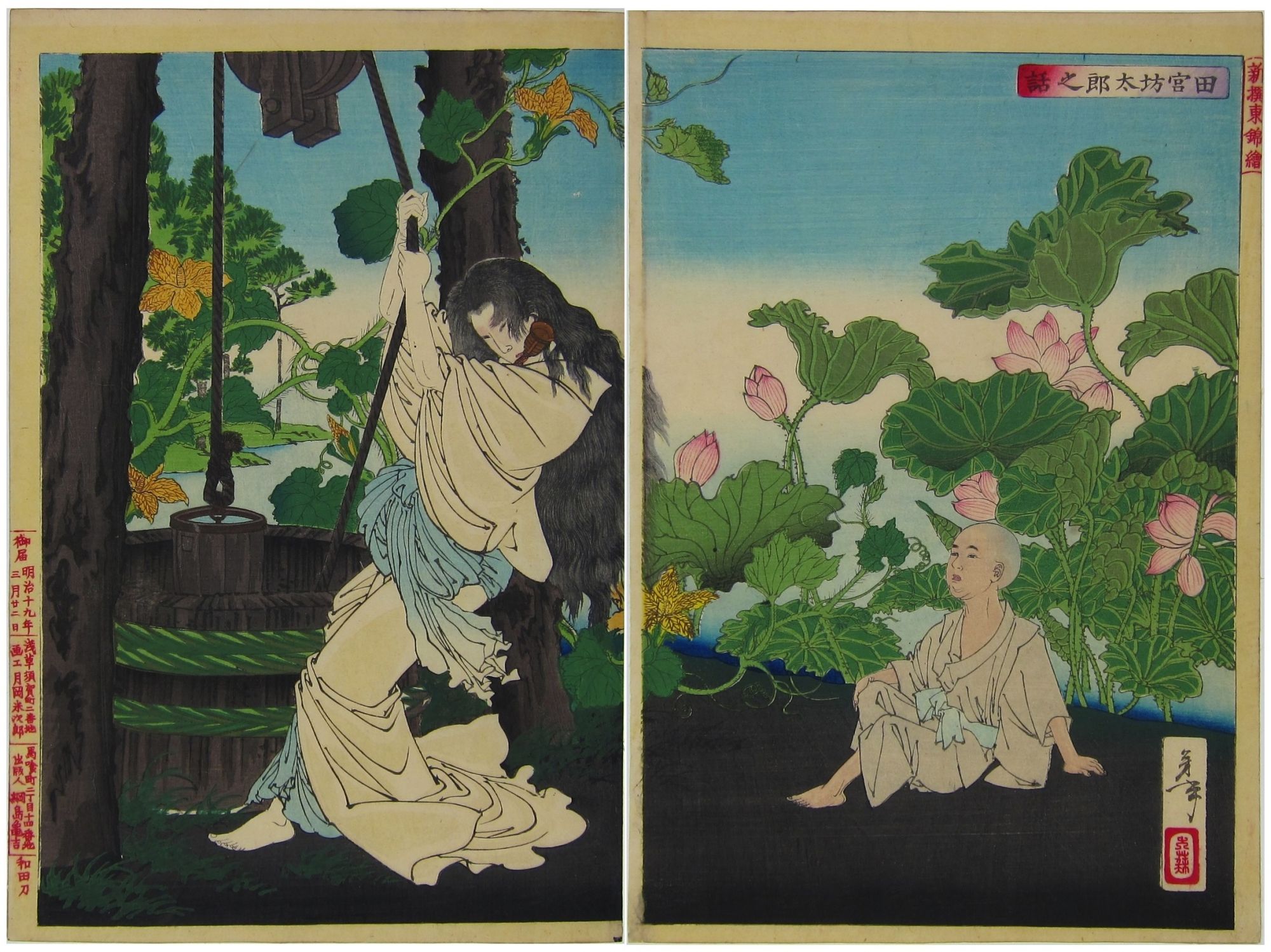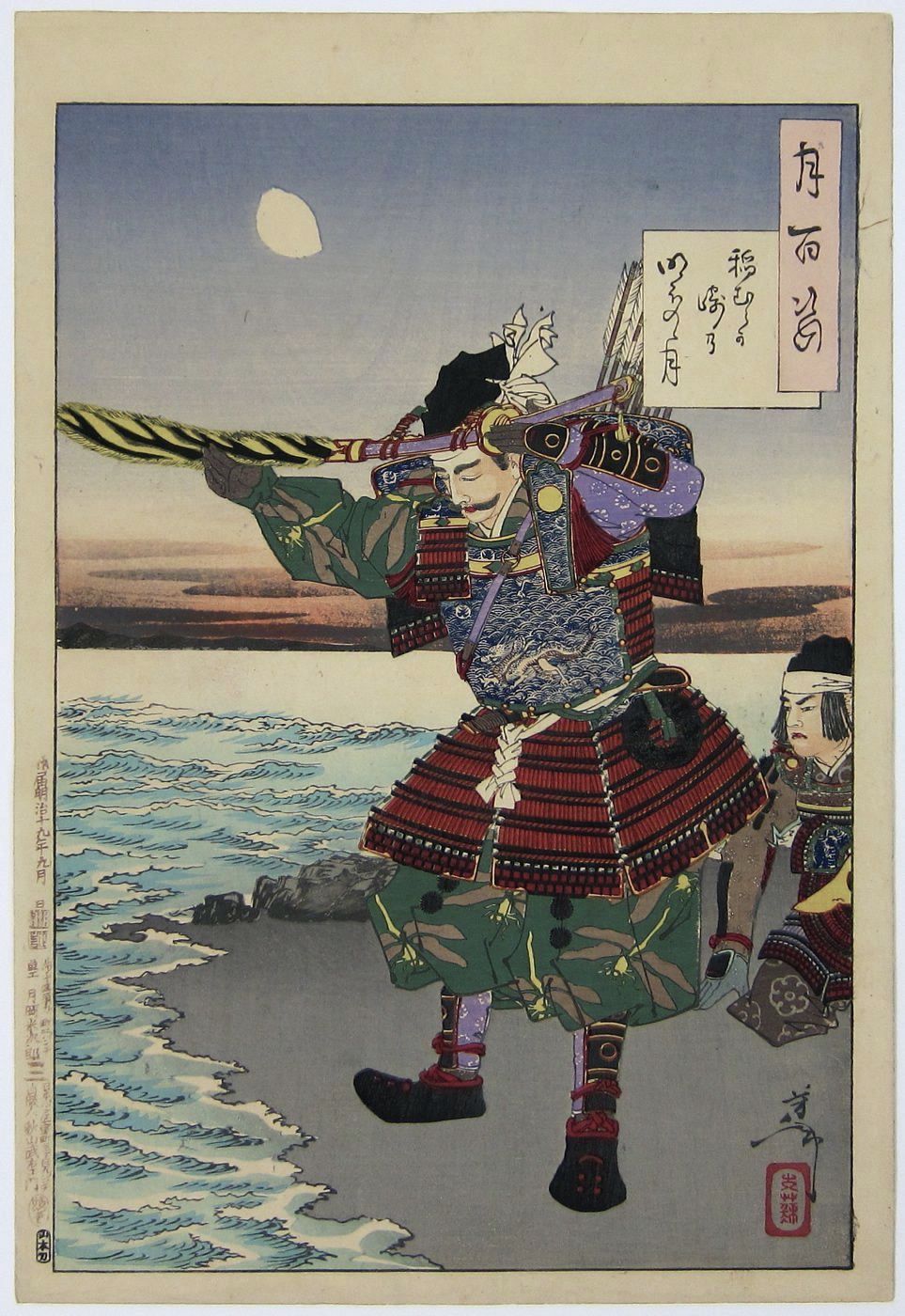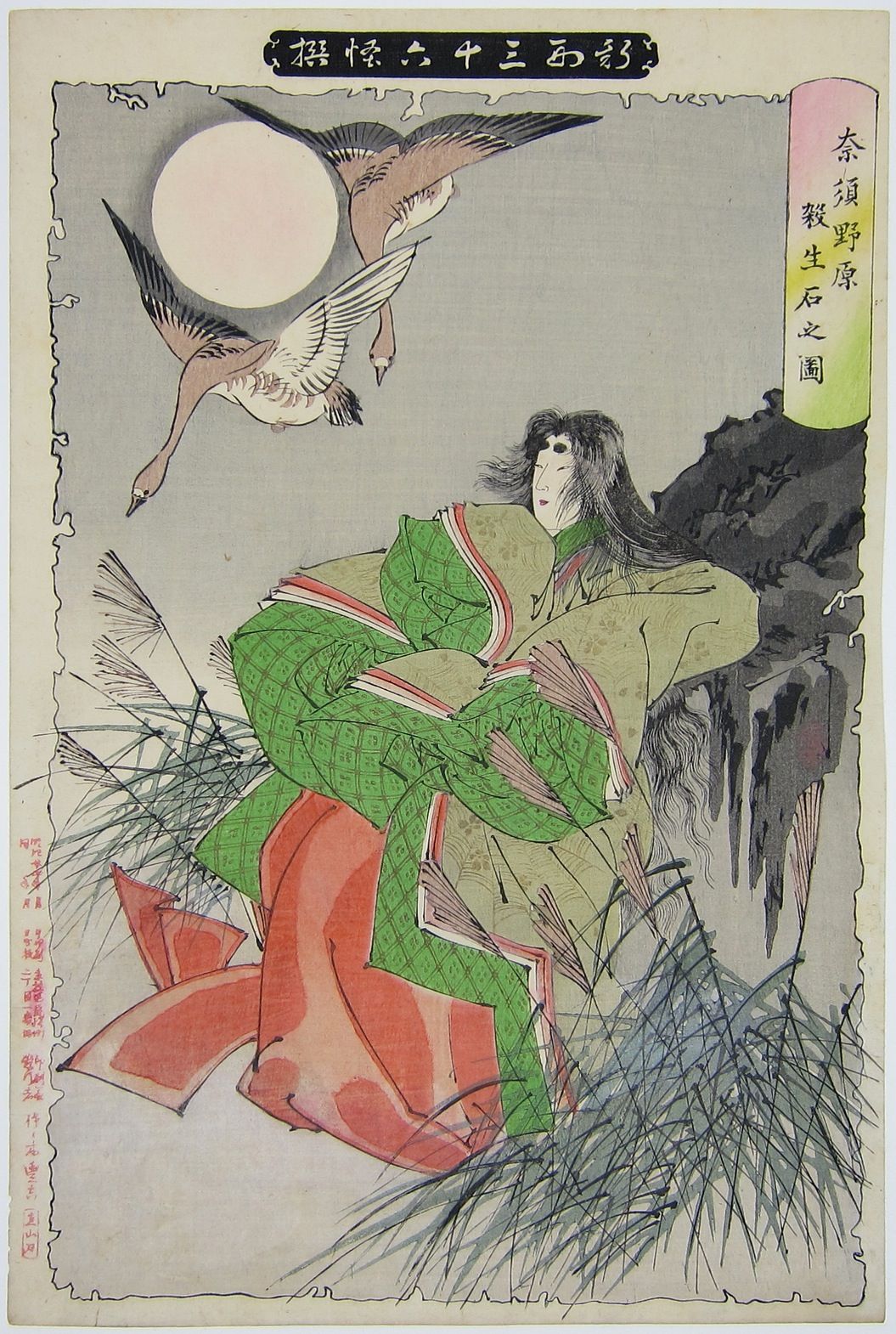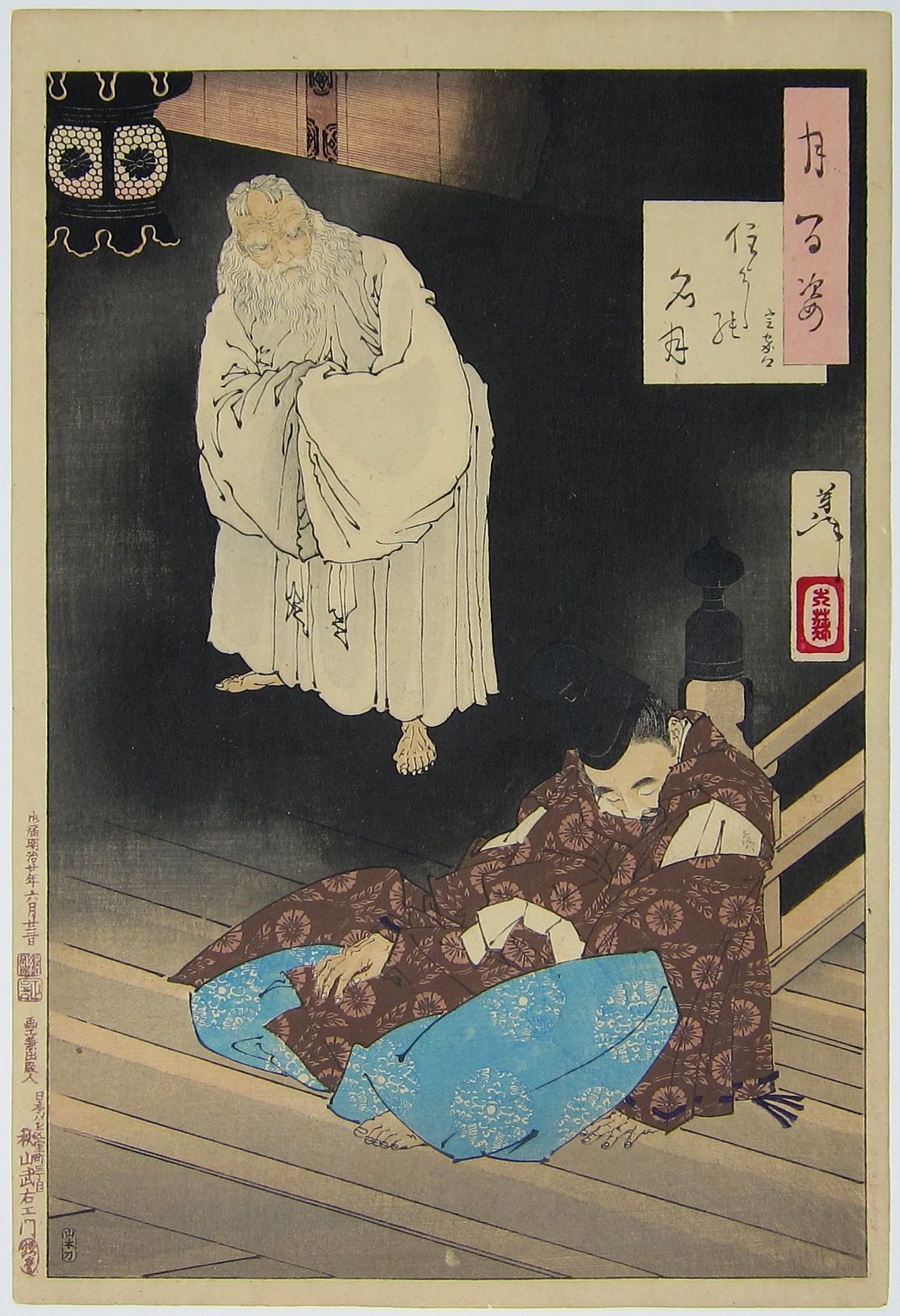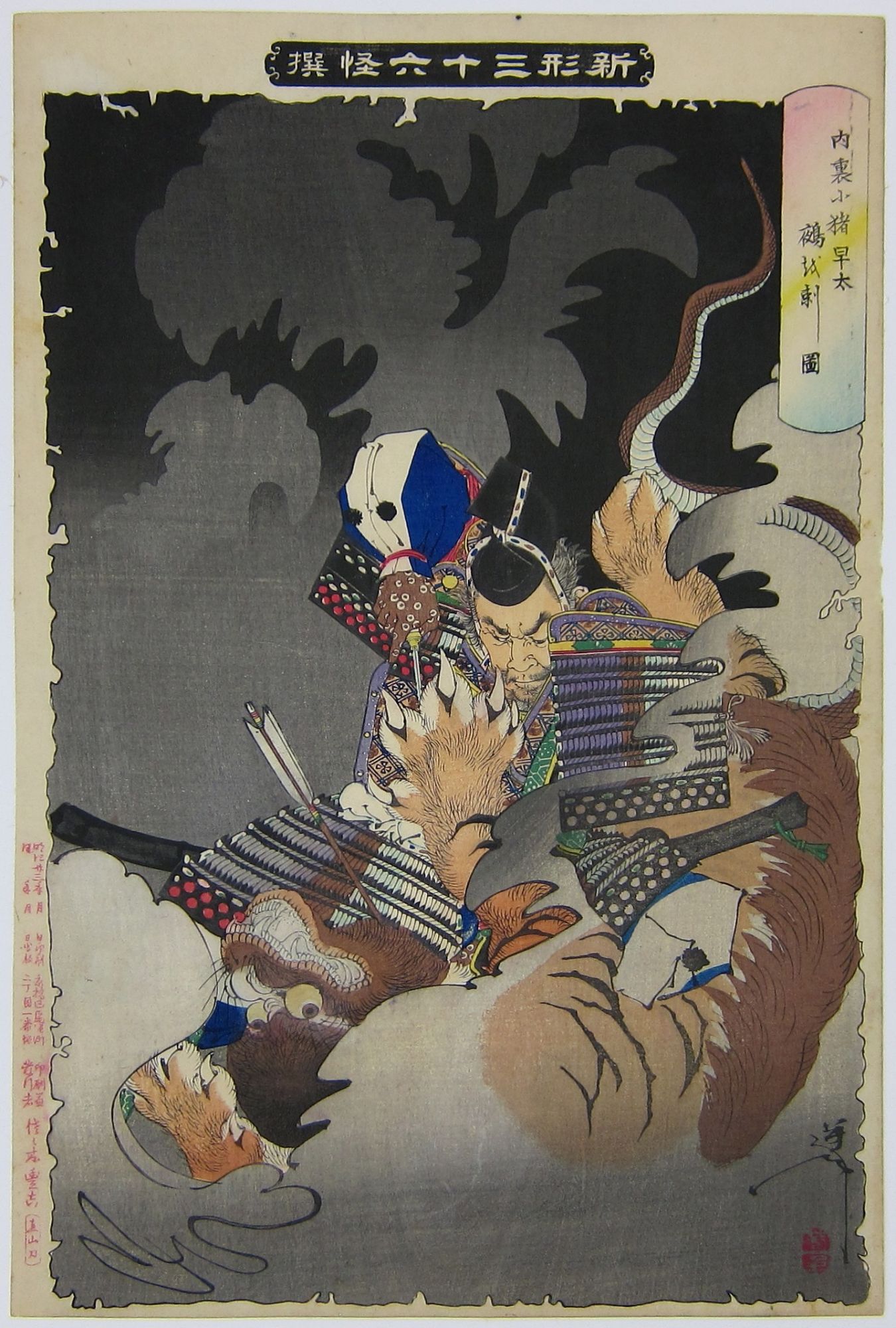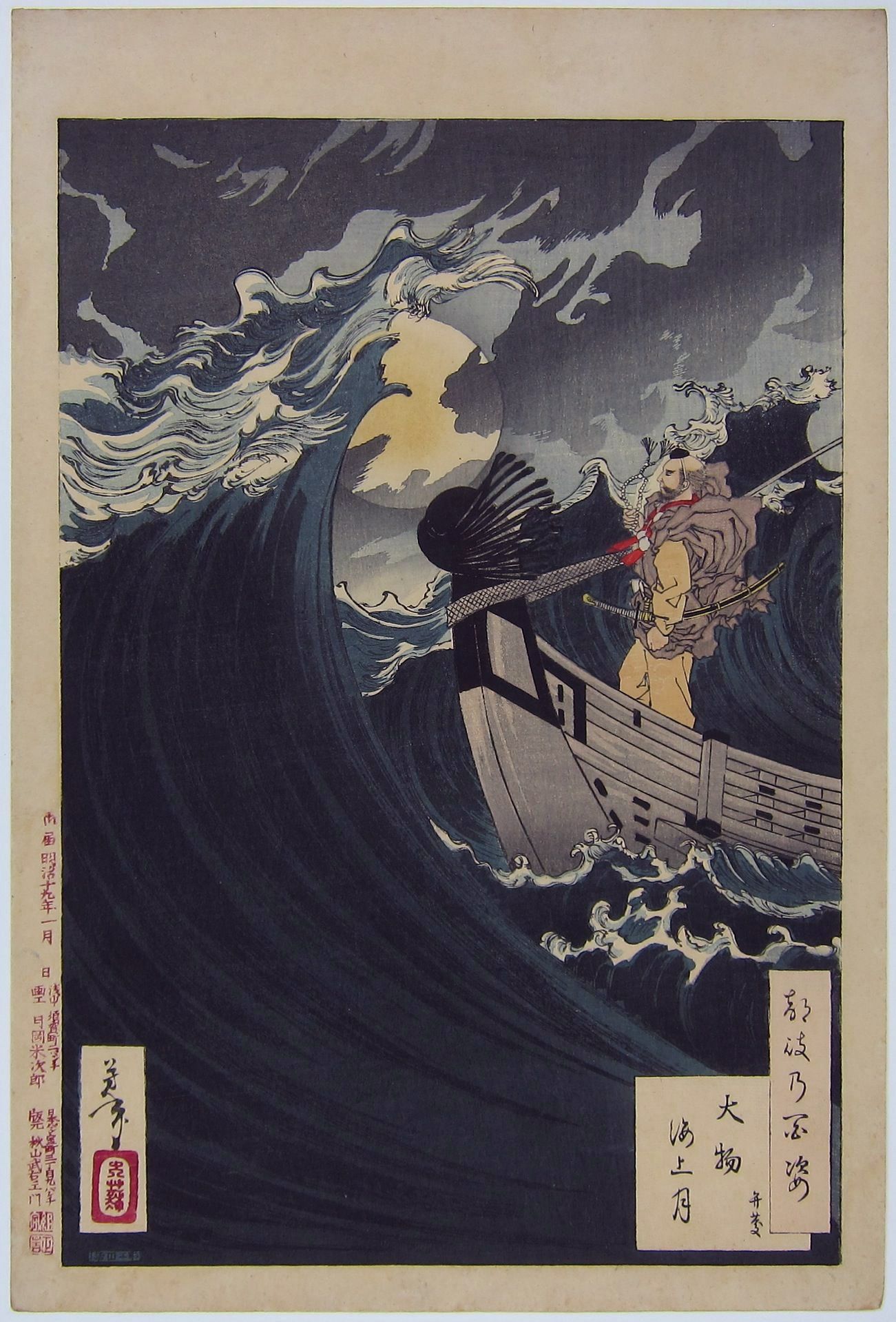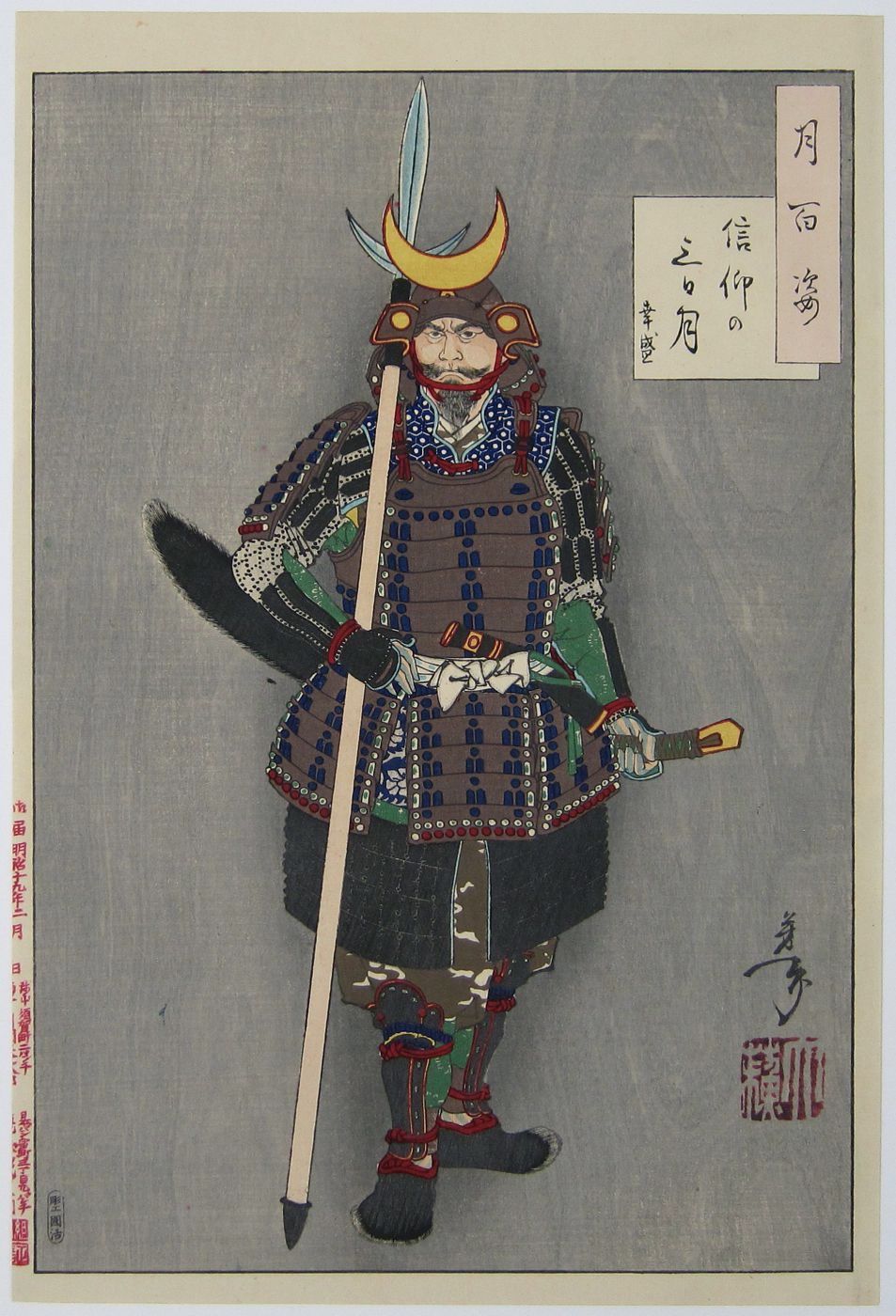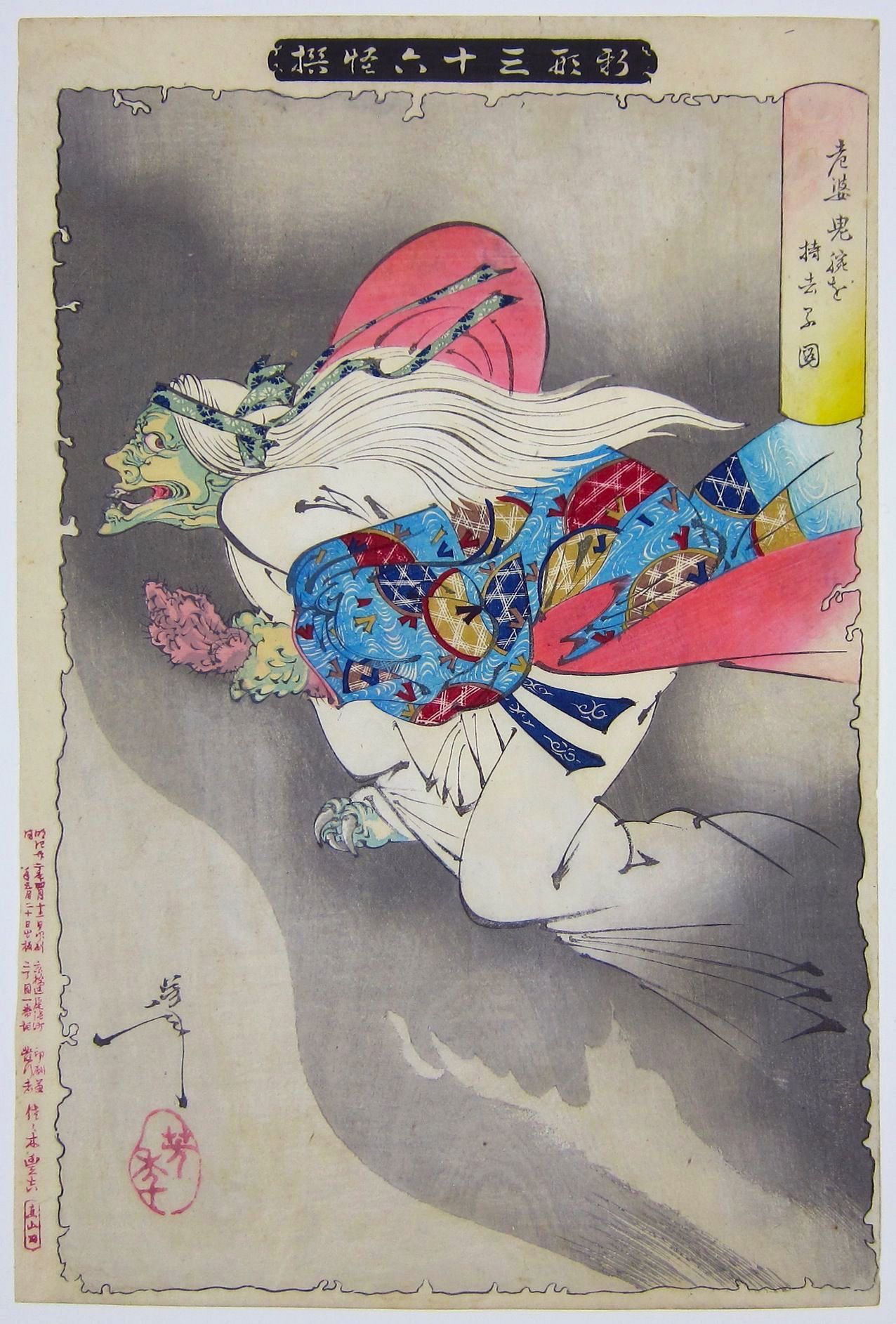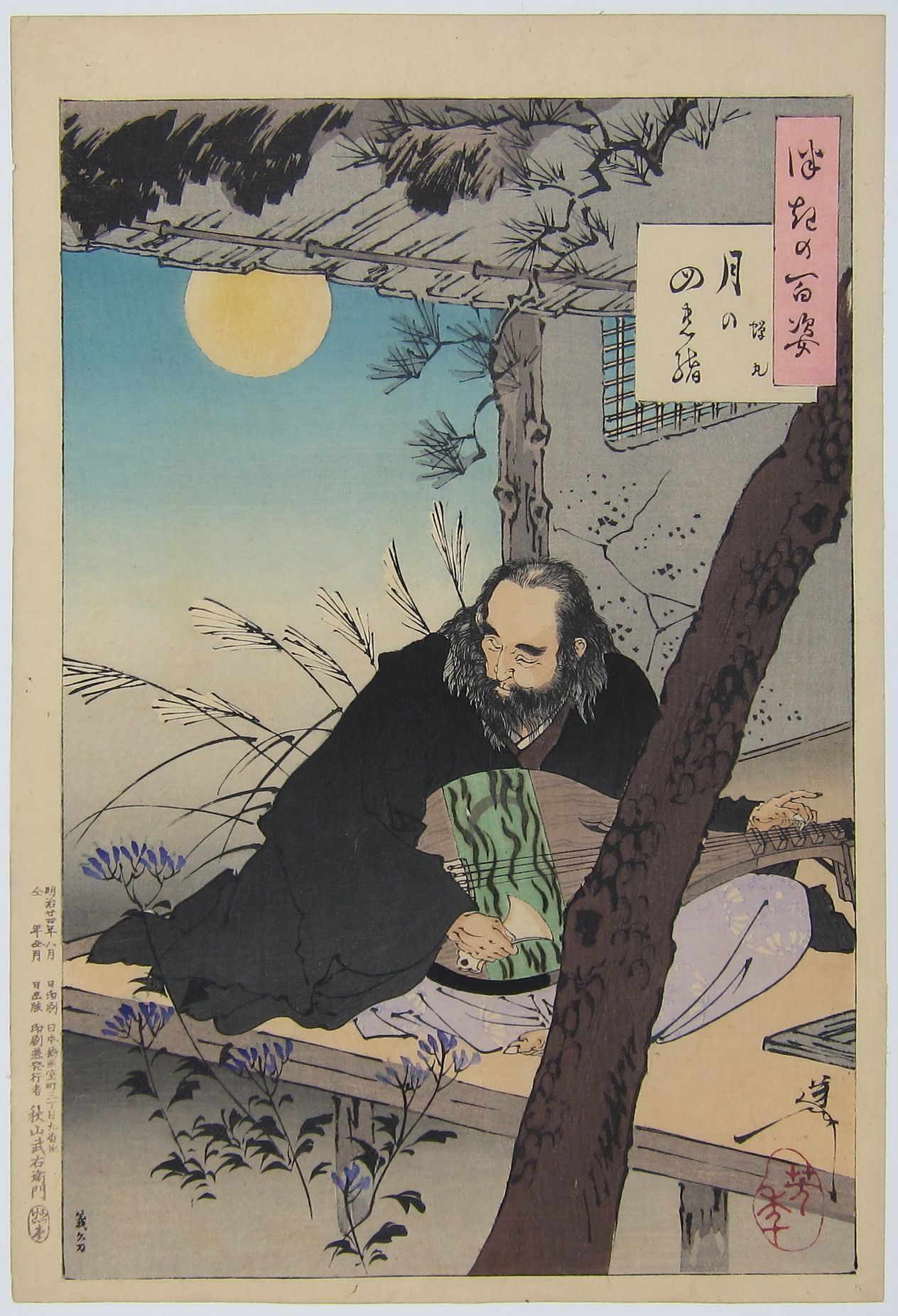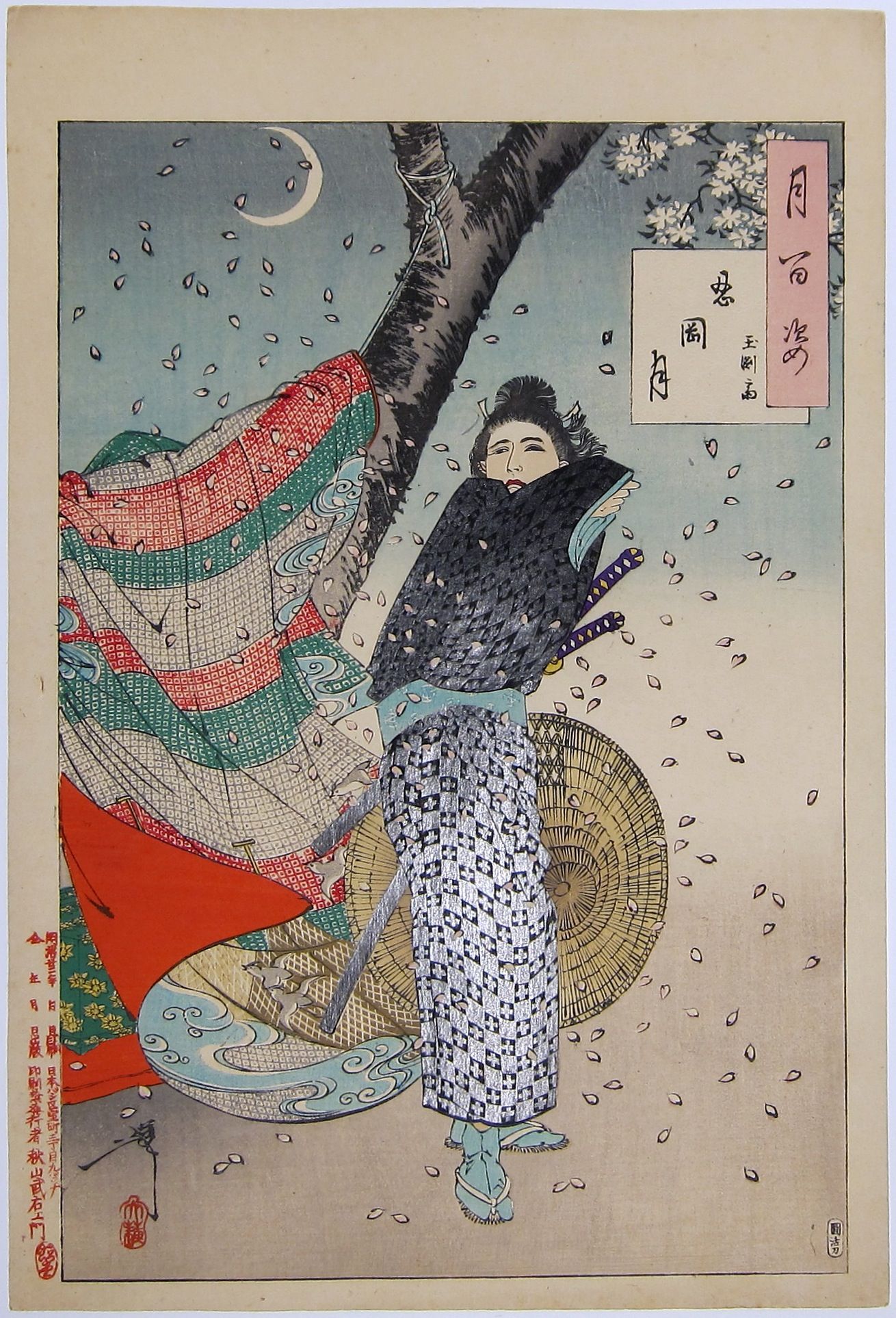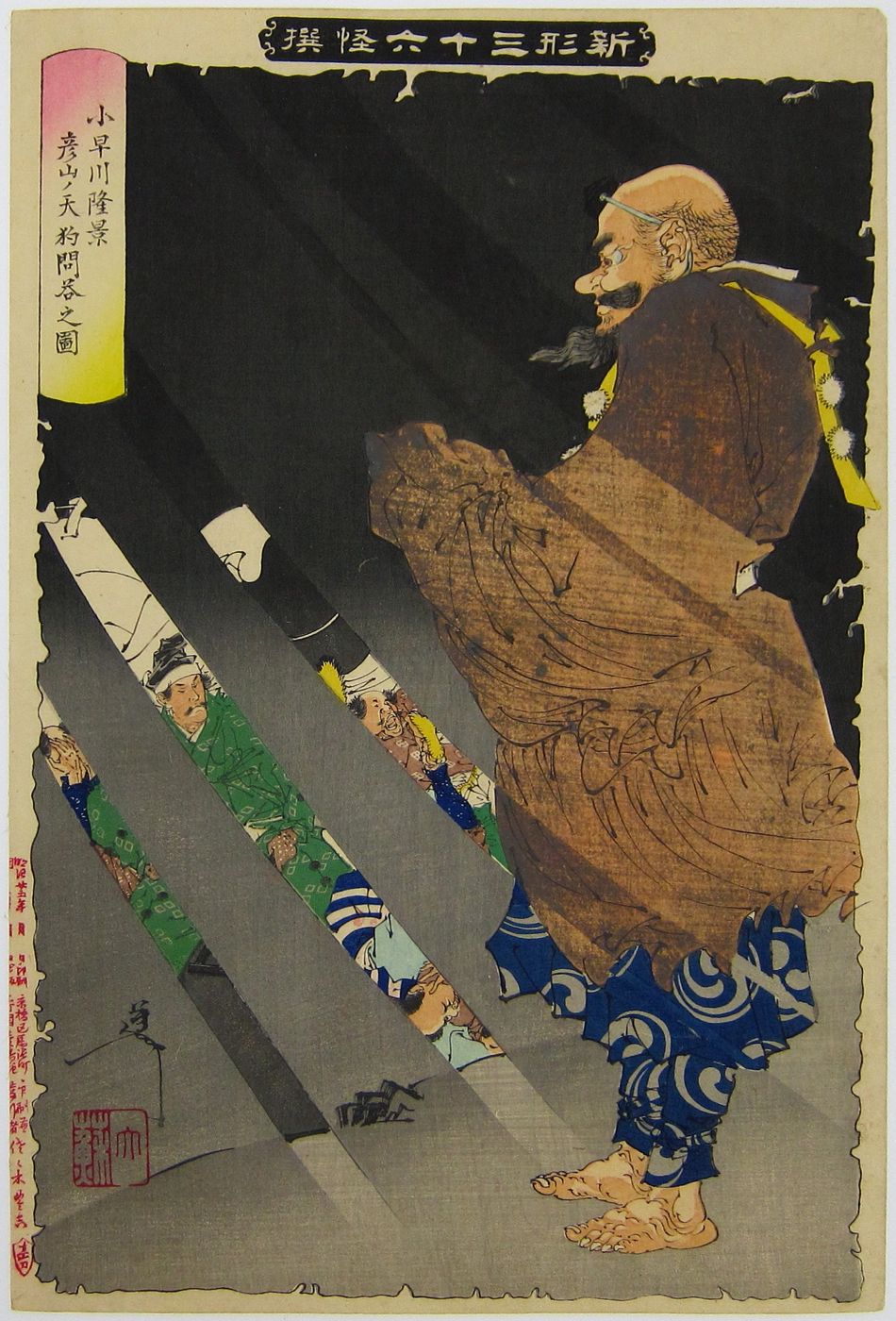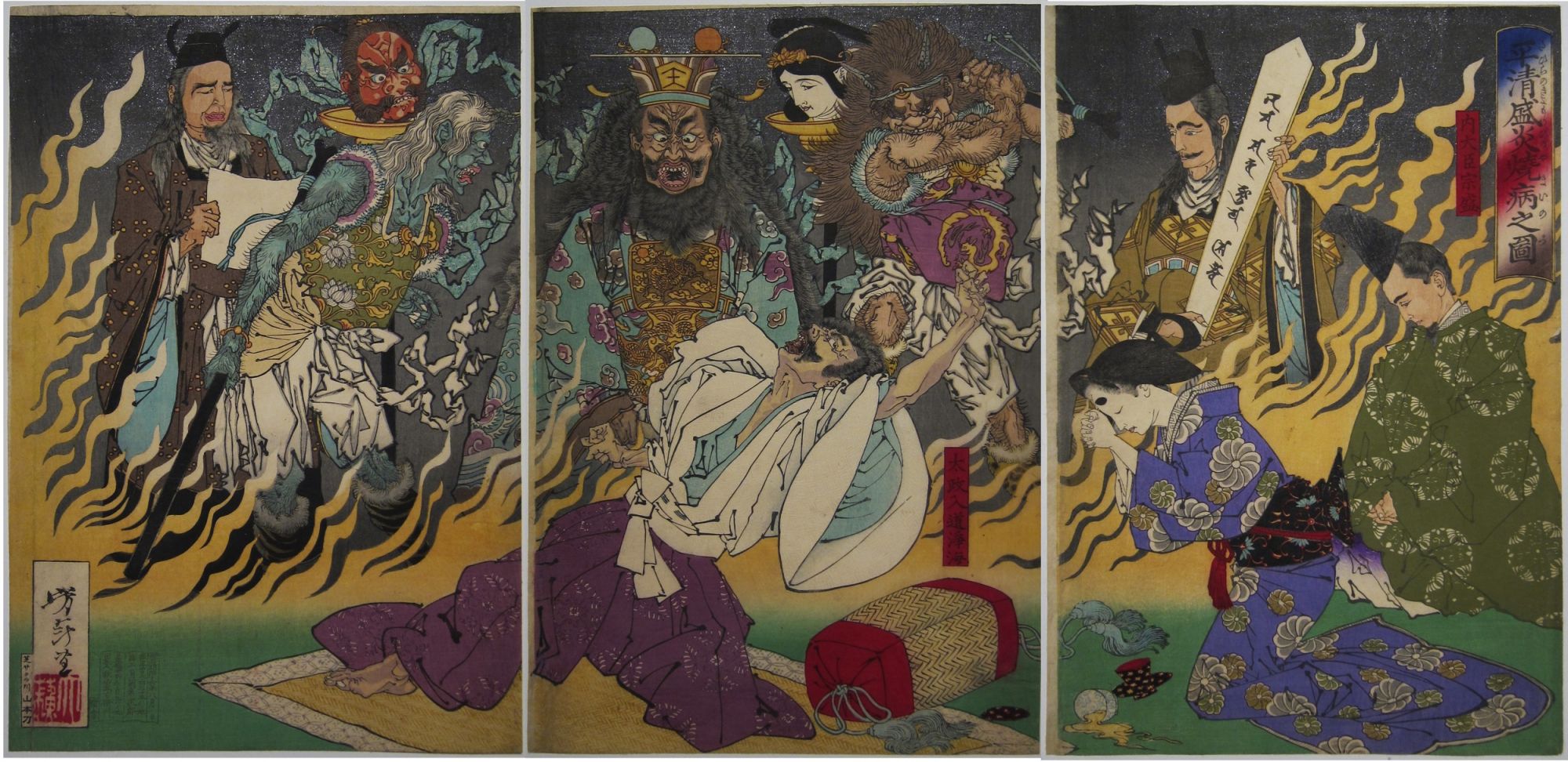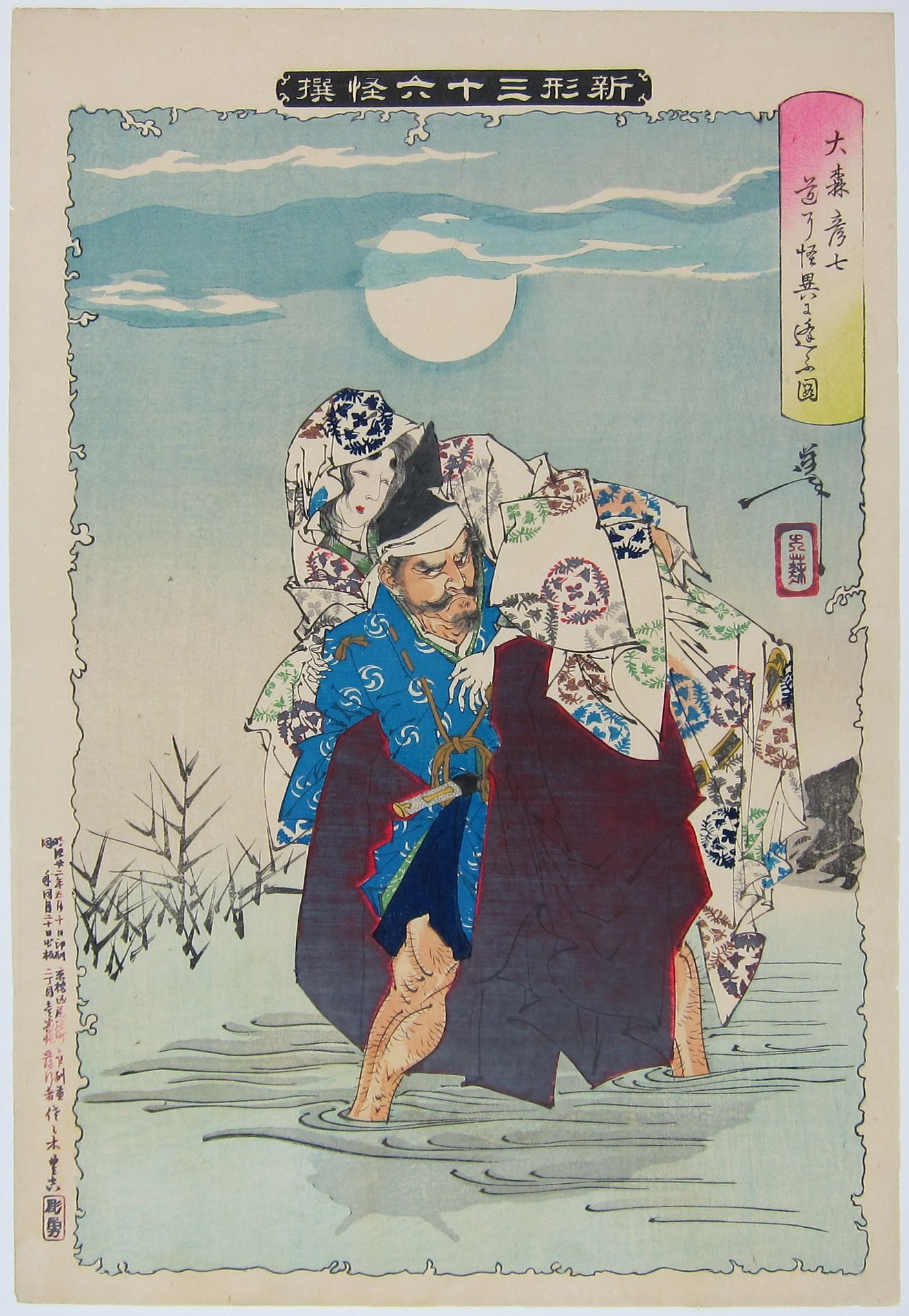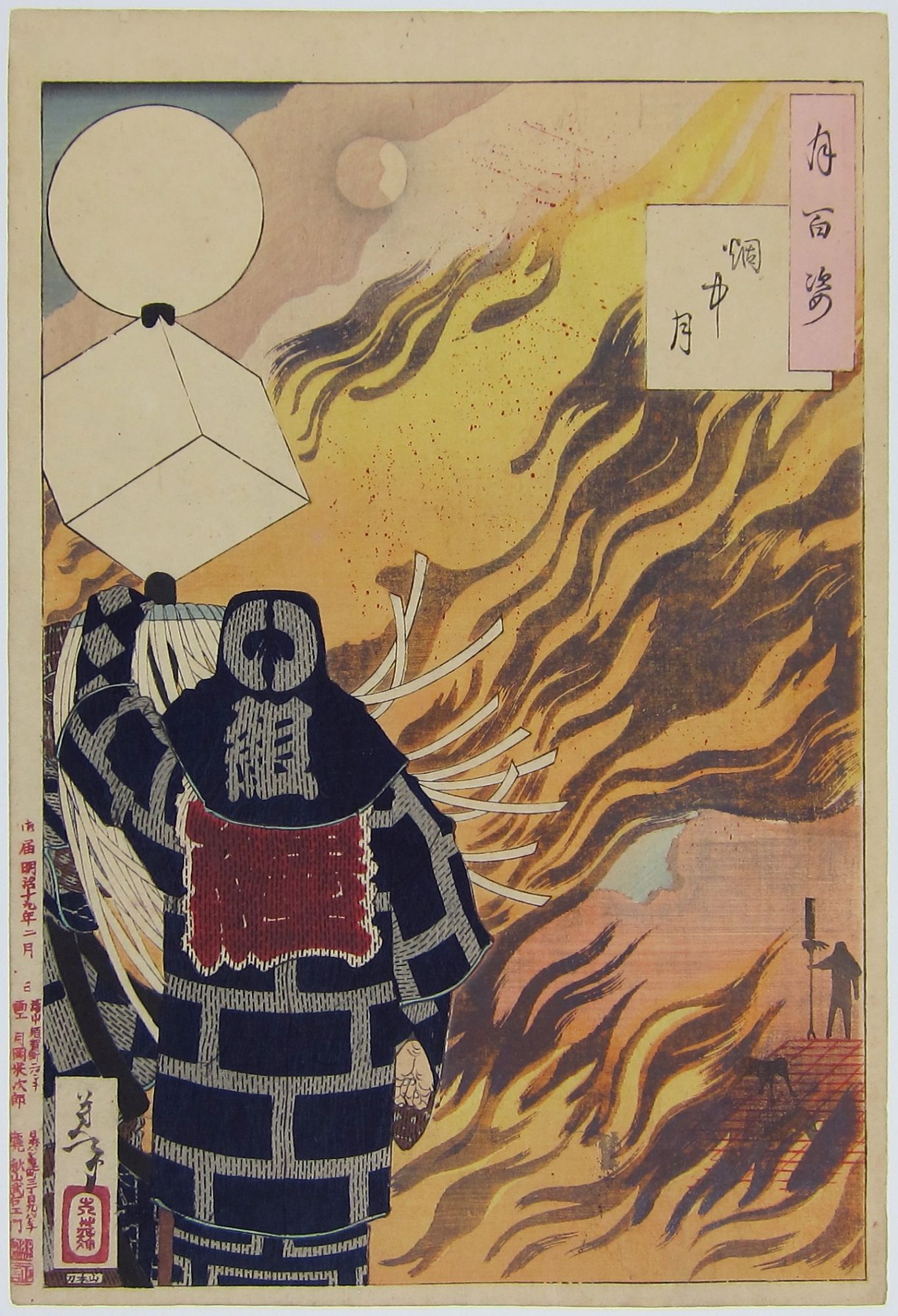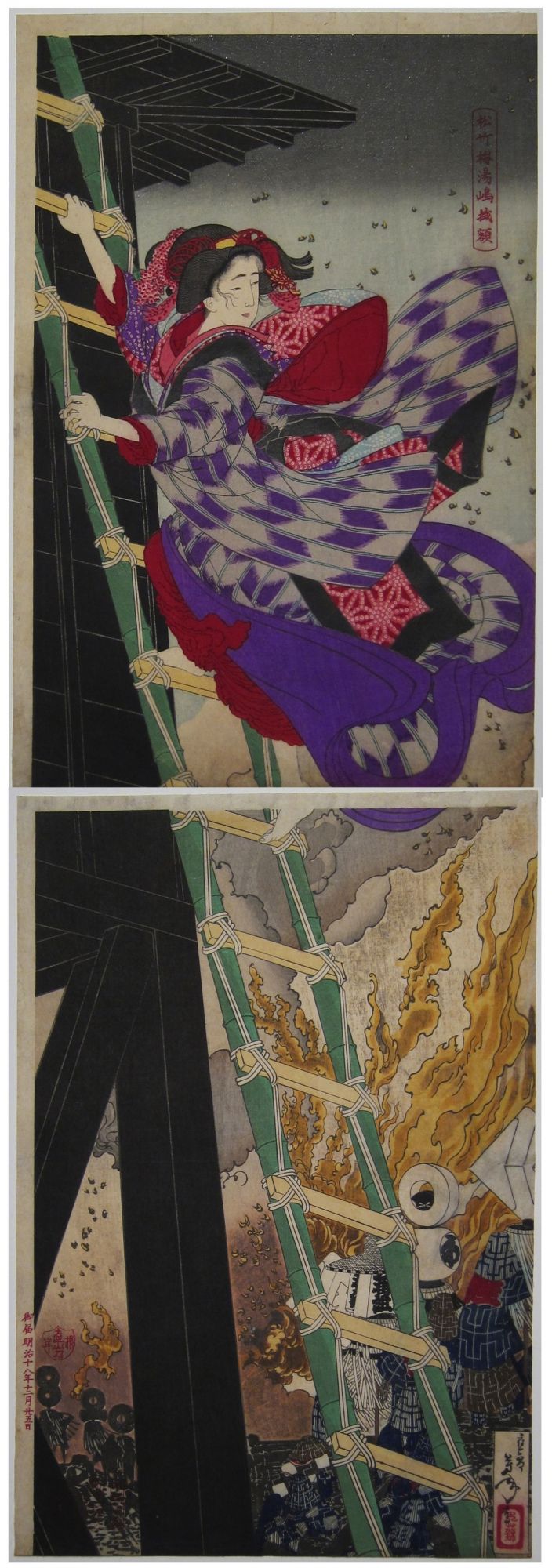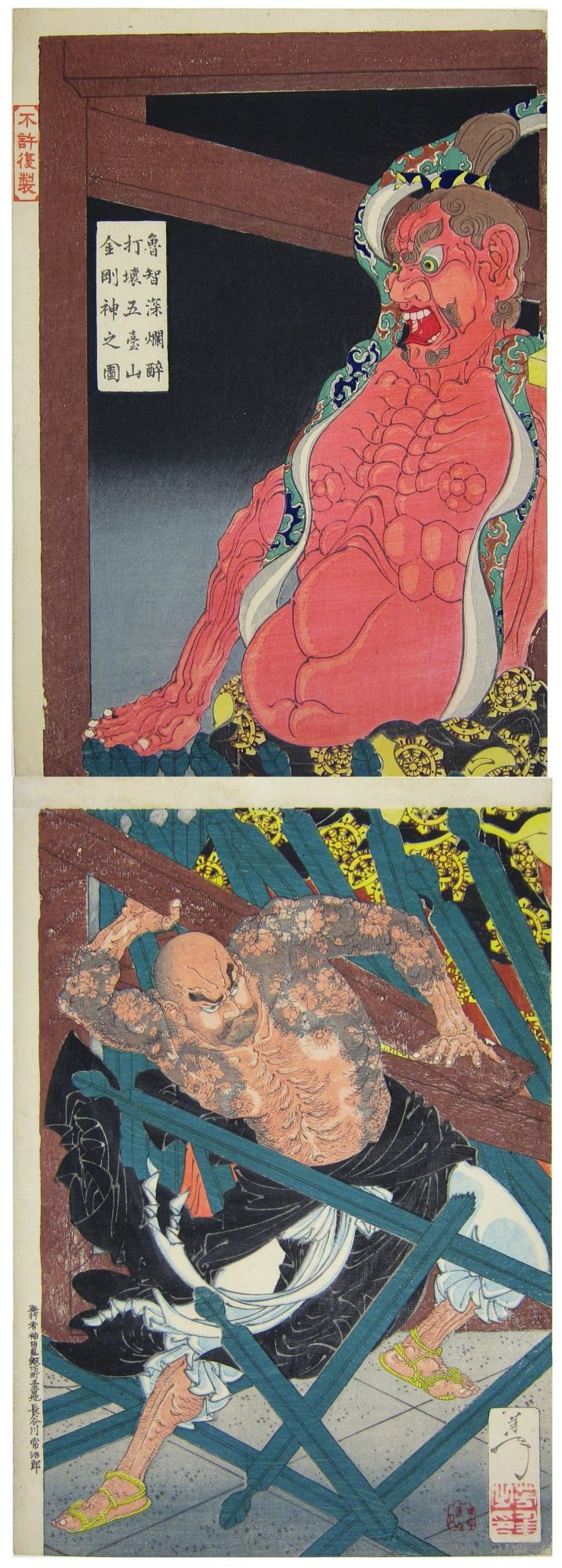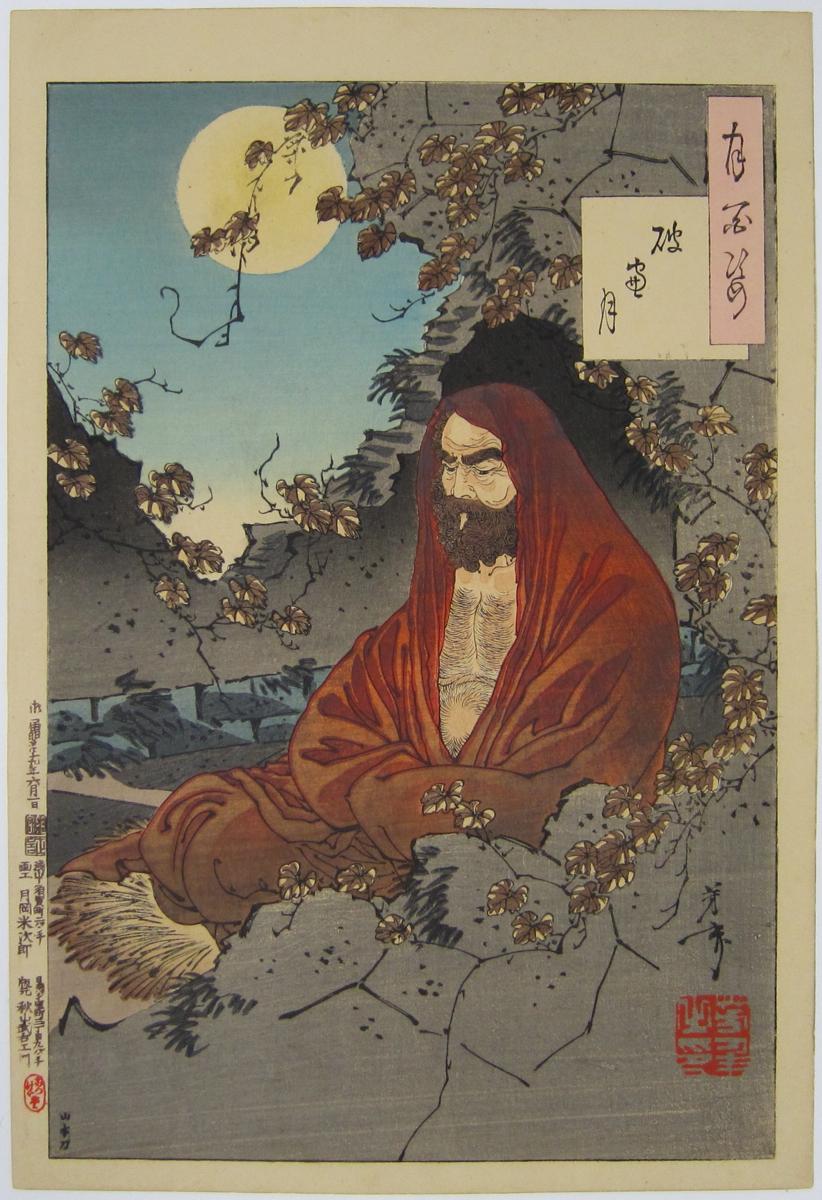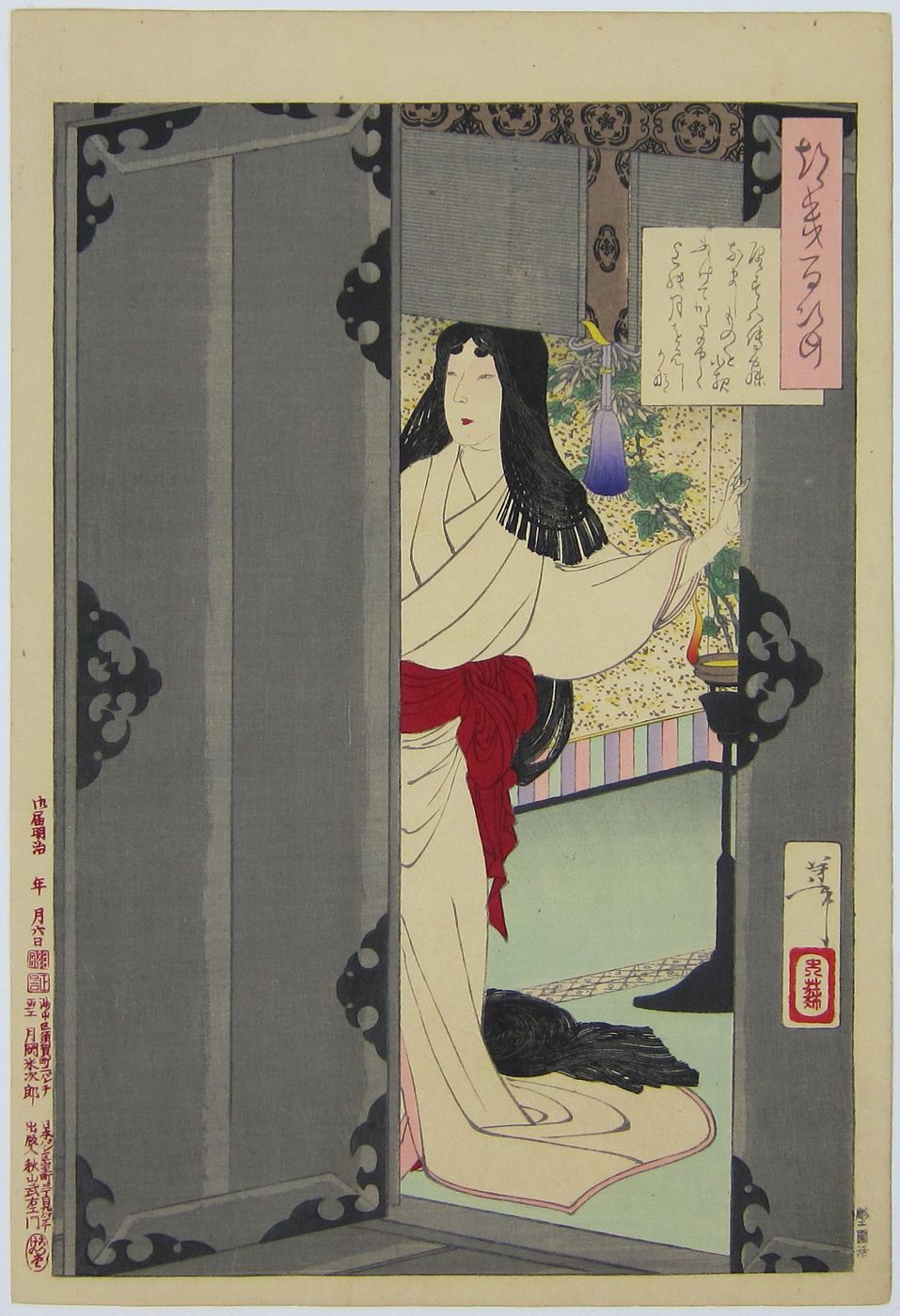YOSHITOSHI Tsukioka. (1839-1892)
Kiyohime Changes into a Serpent at Hidaki River. 1/1890.
- Category
- Japanese | 20th Century
- Series
- 36 Ghosts.
- Publisher
- Sasaki Toyokichi.
- Engraver
- Enkatsu.
ôban tate-e, 24.2 cm × 36.0 cm
Excellent impression of the first state. Mica in the sky, atenashi bokashi shading around the moon. Some trimming, and a slight movement of red around the collar, otherwise very good condition.
Kiyohime fell madly in love with a handsome priest Anchin. He could not reciprocate her worldly passion and in spite of promising to return, he forgets her. Kiyohime's joy turns into hateful anger and she decides to pursue her unrequited love. She finds herself unable to cross the Hidaki river in flooding and overcome with burning rage, turns into a serpent and swims to the other side. She emerges from the water, her back metamorphosing underneath the soaked snake-scale robe and grips her hair with grim resolution. The falling cherry blossom suggest that death is imminent. Anchin is at the Dojoji temple and sees the snake. He hides under a giant bronze temple bell but Kiyohime finds him and coils her serpent body around the bell. In the throes of her white hot fury, it melts and kills them both.
Signed Yoshitoshi, seal Taiso. Ref Plate 11 Pg 104 Yoshitoshi's Strange Tales. John Stevenson. Hotei Publishing.
Sold
YOSHITOSHI Tsukioka. (1839-1892)
The Story of Tamiya Botaro. 1886.
- Category
- Japanese | Warriors War And Legend
- Series
- New Selection of Eastern Brocade Pictures.
- Publisher
- Tsunashima
- Engraver
- Wada Hori Yu
oban diptych, 48.0 cm × 36.0 cm
Very good impression, colour and condition. Slightly trimmed and two minor thin spots.
A famous scene from the kabuki play "Osanago no Adauchi" " A Child's Revenge", in which Botaro watches his nurse, Otsuji, draw water from a well. Botaro's father was murdered by his fencing master because his skill in the discipline threatened the latter's pre-eminence. The boy vows to avenge the death and and pretends to be mute from birth, with the intent of deceiving his foe. Otsuji, however, falls for the ruse. She performs ritual ablutions to the god Konpira, in hope that the boy will regain his speech. Yoshitoshi conveys Ojitsu's perseverance and devotion, as she hauls the bucket of water under the tacit gaze of Botaro.
Signed Yoshitoshi with the artist's seal Taiso and the carver's seal Wada Hori Yu.
Sold
YOSHITOSHI Tsukioka. (1839-1892)
Inamura Promontory moon at daybreak. 8/1886
- Category
- Japanese | 20th Century
- Series
- One Hundred Aspects of the Moon.
- Publisher
- Akiyama Buemon.
- Engraver
- Yamamoto.
oban tate-e, 26.4 cm × 36.9 cm
Very good impression with strong woodgrain. Excellent colour, with oxidation in the lower sky and very good condition.
Nitta no Yoshisada offers his treasured sword to the sea gods at dawn. In 1333, the general ended his allegiance with the Hojo clan and raised an army of twenty thousand men to restore the exiled emperor, Go-Diago, to the castle in Kamakura. His military campaign is impeded when he finds himself trapped at the Inamura Promontary. The Hojo army have fortified both the cliffs and the sea with war ships. As day breaks, Yoshisada offers his sword and the tide recedes, carrying with it the ships and archers, creating a wide expanse of sand, and a passage way for Yoshisada to advance on Kamakura.
Printed 8/1886. Signed: Yoshitoshi. Seal: Taiso. ref: Stevenson, John, "Yoshitoshi's One Hundred Aspects of the Moon", Redmond, WA: San Francisco, Graphic Society, 1992, - plate 39. Reference Impression.
Sold
YOSHITOSHI Tsukioka. (1839-1892)
The Death Stone of Nasu Moor. 1891.
- Category
- Japanese | Warriors War And Legend
- Series
- New Forms of Thirty-six Strange Things.
- Publisher
- Sasaki Toyokichi.
- Engraver
- Chokuzan.
oban tate-e, 24.3 cm × 36.2 cm
Very good impression of the first edition. Good colour. Slight trimming, otherwise very good condition.
The emperor became ill after his favourite concubine, Tanamo no mae, bewitched him with black magic. When asked to approach the altar to pray for his recovery, she reveals her true nature as the nine tailed fox and scampers off to Nasu Moor. The emperor sends the master archer Kuranosuke in hot pursuit. She was shot and turned into the death stone known as sessho seki. Anyone who touched it or even looked at it would die.
The ghost of Tanamo no mae appears here on the desolate moor before the death stone. Her outermost garment is decorated with spider's webs and cherry blossom, a symbol of female entrapment and the rust orange undergarment belies her nature as the fox spirit. The two geese show that death is present and appear to be struggling in flight. Legend had it that birds would die when flying over the rock.
Ref Plate 23. Page 128 Yoshitoshi's Strange Tales. John Stevenson, Hotei Publishing.
£680
YOSHITOSHI Tsukioka. (1839-1892)
Sumiyoshi full moon. Lord Teika.
- Category
- Japanese | Warriors War And Legend
- Series
- One Hundred Aspects of the Moon.
- Publisher
- Akiyama Buemon.
- Engraver
- Enkatsu.
oban tate-e, 24.2 cm × 35.6 cm
Very good impression, embellished with black lacquer. Very good colour and condition.
Lord Teika, a celebrated poet from the 13th century, has fallen asleep on the verandah of a Shinto shrine at Sumiyoshi. The god of poetry would appear in a dream to those who spent a night there. The deity emerges from a black cloud: a superb technique on the part of the printer called atenashi bokashi, borderless printing. The shades of grey in the old man's robes have been printed to give the effect of shadows and the forehead bulges like a peach indicating his wisdom as an immortal.
Signed Yoshitoshi, seal Taiso. Engraver seal; Yamamoto.
Reference: Plate 53,Yoshitoshi's One Hundred Aspects of the Moon. John Stevenson. ISBN 978-0963221803
£480
YOSHITOSHI Tsukioka. (1839-1892)
Ii no Hayata Kills the Nue at the Imperial Palace. 1890.
- Category
- Japanese | Warriors War And Legend
- Series
- New Forms of Thirty-six Strange Things.
- Publisher
- Sasaki Toyokichi.
- Engraver
- Chokuzan.
ōban tate-e, 24.1 cm × 36.0 cm
Very good impression with three colour cartouche, embellished with black lacquer and mica. Very good colour. Some trimming, otherwise very good condition.
Ii no Hayata grapples with the nue, a chimera-like monster which had a monkey's head, badger's body, tiger's legs and a snake for a tail.
The emperor had trouble sleeping because of strange bird-like screams and abrasive scratching above the imperial palace. Petrified, he demanded that Lord Minamoto no Yorimasa discover the cause. In the thick of night, the commander saw a black cloud form over the palace, and shot an arrow into the darkness. A creature fell from the sky, writhing on the ground with an arrow piercing its neck. It was left to Yorimasa's henchman, Ii no Hayata, to finish the beast off with a dagger. Signed Yoshitoshi. Plate 10 John Stevenson 'Yoshitoshi's Strange Tales'
£980
YOSHITOSHI Tsukioka. (1839-1892)
Moon over Daimotsu Bay. 1/1886.
- Category
- Japanese | 20th Century
- Series
- One Hundred Aspects of the Moon.
- Publisher
- Akiyama Buemon.
- Blockcutter
- Enkatsu.
ōban tate-e, 25.2 cm × 37.4 cm
Very good impression, mica on the waves. Not from an album so no offsetting from Kikaku plate around Benkei. Large margins lightly soiled and minimally toned, otherwise very good condition.
Yoshitsune no Minamoto led a decisive victory at the Battle of Dannoura in 1185, whereupon warriors of the rival Taira clan drowned in the straits of Shimonoseki. Yoshitsune is subsequently outlawed by his half-brother Yoritomo and forced to flee Kyoto by sea with his retainer, Benkei. They encounter a tempestuous storm, summoned by the vengeful spirits of the Taira clan.
Benkei stands at the prow of the boat dressed as a mountain ascetic yamabushi and offers Buddhist prayers and spells to quell the ghostly apparitions that emerge from the crests of the waves. Signed Yoshitoshi, seal Taiso.
Sold
YOSHITOSHI Tsukioka. (1839-1892)
Faith in the third-day Moon. 2/1886
- Category
- Japanese | 20th Century
- Series
- One Hundred Aspects of the Moon.
- Publisher
- Akiyama Buemon.
- Engraver
- Enkatsu.
oban tate-e, 26.0 cm × 38.0 cm
Very good impression with woodgrain and embellished with black lacquer. Superb colour. Lightly backed and trimmed left margin, otherwise very good condition.
The samurai of the crescent moon, Yukimori, glares at the viewer with ferocious intensity. The moon appears both as a half crescent on his helmet, and also on his kamayari "sickle spear". The crescent moon is a lucky emblem (mikazuki) and in addition to making him stand out on the field, Yukimori believed its adornment on his helmet would bring him good fortune in battle.
Signed Yoshitoshi seal Taiso. Ref Plate 23 John Stevenson, "Yoshitoshi's One Hundred Aspects of the Moon" IBSN 978-0963221803
Sold
YOSHITOSHI Tsukioka. (1839-1892)
The Old Woman Retrieves Her Arm. 4/1889.
- Category
- Japanese | 20th Century
- Series
- New Forms of Thirty-six Strange Things.
- Publisher
- Sasaki Toyokichi.
- Engraver
- Chokuzan.
ōban tate-e, 23.8 cm × 35.8 cm
Very good impression with strong woodgrain. Very good colour. Slightly trimmed; very light surface soil, otherwise very good condition.
The 10th century general Watanabe no Tsuna fell asleep one night while keeping watch at the Rasho Gate. His slumber is interrupted by a wrench to his helmet and he brandishes his sword, cutting off the huge hairy arm of his assailant, the demon Ibaraki. A few days later his elderly aunt, Mashiba, visits and asks to see the monstrous limb with claws. Watanabe realises that his aunt is in fact Ibaraki in disguise, as she grabs the severed arm and flies away. Signed Yoshitoshi, Seal: Taiso.
Sold
YOSHITOSHI Tsukioka. (1839-1892)
The Moon's Four Strings. Semimaru. 8/1891.
- Category
- Japanese | 20th Century
- Series
- One Hundred Aspects of the Moon.
- Publisher
- Akiyama Buemon.
- Engraver
- Yoshihisa
oban tate-e, 25.0 cm × 36.4 cm
Very good impression, colour and condition. Beautiful shading on Semimeru's robe, overprinting and brass.
Semimaru, the blind musician, who served the son of Emperor Uda, but in old age lives as a hermit in a dilapidated straw thatched cottage in the mountains near Kyoto. He plays his biwa upon which a crescent moon emblem echoes the luminous moonlight that floods the veranda. Signed Yoshitoshi. Seal Yoshitoshi.
Sold
YOSHITOSHI Tsukioka. (1839-1892)
Shinobugaoka Moon. 1889.
- Category
- Japanese | 20th Century
- Series
- One Hundred Aspects of the Moon.
- Publisher
- Akiyama Buemon.
- Engraver
- Enkatsu.
ōban tate-e, 25.2 cm × 37.8 cm
Excellent impression, colour and condition. Beautiful shōmenzuri on the black robe.
The young samurai Gyokuensai stands underneath a crescent moon and shields himself from a zephyr of cherry blossom. He has been viewing cherry blossoms by moonlight (yozakura) at Shinobugaoka. A kimono is hoisted between two trees to act as a shelter. The light wind stirs up the robe which is decorated with plovers taking flight over the waves. Gyokuensai's stance and anxious expression amidst the flurry of petals create a palpable sense of foreboding. Signed Yoshitoshi. Seal Taiso. Reference: Plate 76. John Stevenson, "Yoshitoshi's One Hundred Aspects of the Moon" IBSN 978-0963221803.
Sold
YOSHITOSHI Tsukioka. (1839-1892)
Kobayakawa Takakage Debating with the Tengu of Mount Hiko. 1892.
- Category
- Japanese | 20th Century
- Series
- New Forms of Thirty-six Strange Things.
- Publisher
- Sasaki Toyokichi
- Engraver
- Chokuzan.
oban tate-e, 25.9 cm × 35.9 cm
Very good impression, colour and condition. Trimmed margins.
Kobayakawa Takakage (1532-1597), a brilliant military leader, was camped one day with his army on the slopes of Mount Hiko. A cold wind arose, and a Tengu (mythical creature with a long nose) appeared, upset at the disturbance caused by the military presence. The Tengu here wears a dark brown robe, and has a pill box attached to his forehead, part of the traditional tengu attire. Yoshitoshi shows the sudden gust of wind and apparition with striking graphic design. Through swathes cut away, the encampment awning bellows and we see the terrified army falling down in terror. The fearless Kobayakawa sits on his folding stool, ready for his interview with the goblin. Signed Yoshitoshi. Seal Taiso
Sold
YOSHITOSHI Tsukioka. (1839-1892)
The Fever of Taira no Kiyomori. 8/1883
- Category
- Japanese | 20th Century
- Publisher
- Akiyama Buemon.
- Blockcutter
- Shiba Sakuragawa Yamamoto (Yamamoto Shinji)
oban triptych, 76.3 cm × 25.2 cm
Excellent, early impression with blind embossing, burnishing and extensive mica. A light fold line on far right and centre, and weak paper spot bottom sheet, slight trimming, otherwise very good condition.
The Heike Monogatari (Tale of the Heike) tells the story of the feud between the Minamoto (Genji) and Taira (Heike), the latter gaining supremacy in 1159, led by Kiyomori, who thereafter ruled as a dictator until his death in 1181.
Kiyomori was tormented by the crimes committed under his tyranny and suffered a fever, so hot, that the water boiled when he bathed. In this vision of hell, he recoils in agony attended by his praying wife and son, with Enma, the King of Hell in the background. The heads of his victims are offered to him on bronze platters. Signed Yoshitoshi, Sealed: Taiso; Block cutter; Yamamoto tô
Sold
YOSHITOSHI Tsukioka. (1839-1892)
Omori Hikoshichi Encounters a Demon. 1889.
- Category
- Japanese | 20th Century
- Series
- New Forms of Thirty-six Strange Things.
- Publisher
- Matsui Eikichi.
- Engraver
- Hori Yu.
ōban tate-e, 25.4 cm × 36.8 cm
Very good impression, colour and condition. Attractive oxidisation of the red robe. Large margins.
According to Japanese legend, a shadow shows a supernatural creatures true nature, so a ghost can be revealed by a shadow cast on a shoji screen, or the reflection in a mirror or water.
Omori Hikoshichi, who has been victorious at the battle of Minogatawa 1336, meets a beautiful woman dressed in sumptuous robes. The gallant officer offers to carry this damsel in distress across a stream. The moon is behind them, and Omori sees the horned shadow which is cast on the water, revealing her true demonic identity. Omori reaches for his scabbard, here partly obscured by her robes, and kills her.
Sold
YOSHITOSHI Tsukioka. (1839-1892)
Moon and Smoke. Enchû no tsuki. 2/1886
- Category
- Japanese | 20th Century
- Series
- One Hundred Aspects of the Moon.
- Publisher
- Akiyama Buemon.
- Blockcutter
- Yamamoto.
oban tate-e, 24.8 cm × 36.5 cm
Very good impression with splattered lead very good colour and condition. Slightly trimmed.
A fireman stands in front of a blazing inferno holding aloft his standard, called a matoi. The heavy, quilted jacket bears characters which indicates he belongs to 'Troop Number One'. In the distance amidst the flames, a fireman from a rival company can be seen holding a different standard. One of the best designs from this series. Signed Yoshitoshi. Seal Taiso.
Sold
YOSHITOSHI Tsukioka. (1839-1892)
The Rescue of Oshichi. 1885
- Category
- Japanese | 20th Century
- Series
- Eight Vertical Diptychs.
- Publisher
- Matsui Eikichi.
vertical ōban diptych, 25.2 cm × 74.2 cm
Excellent impression with mica and excellent colour. A reinforced small crease (now flattened), small repair to the matoi and tiny bleed of the red seal, otherwise very good condition.
From a superb set of eight vertical diptychs by Yoshitoshi. Oshichi descends a ladder held by a fireman. She fell in love with the handsome temple page, Saemon, whom she met at the Enjoji temple while seeking refuge during a great city inferno. In the hope they might meet again, she set fire to her home a year later. She was punished for her arson and burnt at the stake. In alternate Kabuki versions, Oshichi is portrayed in a more virtuous light, climbing the fire tower to ring the alarm bell and save her lover. The penalty for a false alarm, however, was death. Signed Oju Yoshitoshi.
Sold
YOSHITOSHI Tsukioka. (1839-1892)
Roshichin in a drunken rage smashing the guardian figure at the temple on Five-Crested Mountain. 1887.
- Category
- Japanese | 20th Century
- Publisher
- Hasagawa.
vertical ōban tate-e diptych, 26.5 cm × 74.2 cm
Very good impression with extensive kirazuri (mica), tsuyazumi (black lacquer). Pristine colour. Excellent condition with full margins.
Roshichin demolishes the gate at the temple of the Five-Crested Mountain. The military captain was a roguish character. After commiting murder, he escapes the death penalty by agreeing to become a priest at the temple. The incorrigible Roshichin returns one night in a drunken stupor. He stumbles into the temple gate and as the whole edifice tumbles to the ground, he attacks the terrifying guardian figure looming above him.
Roshichin is a popular character from Suikoden (The Water Margin), the seminal Chinese work regaling the exploits of a group of brigands in the Northern Provinces, retold in a popular Japanese novel in 1823. He is depicted here in the usual virile way: hirsute and his torso covered in a cherry blossom tattoo.
The publisher Hasagawa purchased the blocks from Heikichi in 1887 and his name and address are in the lower left margin. The red seal in the top margin reads 'reproduction not permitted'. Signed Yoshitoshi with Taiso seal. To the left the engraver seal Negishi Chokuzan tô.
Sold
YOSHITOSHI Tsukioka. (1839-1892)
The moon through a crumbling window (Haso no tsuki). 6/1886.
- Category
- Japanese | 20th Century
- Series
- 100 Aspects of the Moon.
- Publisher
- Akiyama Buemon
- Engraver
- Yamamoto
oban tate-e, 24.7 cm × 36.7 cm
Very good impression, colour and excellent condition. Attractive oxidation to the robe normal with expensive pigments.
Bodhidharma (Daruma in Japanese), founder of Zen Buddhism, meditates in a cave for nine years after being refused entry to the Shaolin Monastary. He cut off his eyelids in anger, after falling asleep two years into the meditation. Tea plants grew where they fell and the vines cling and creep around the crumbling walls. This is why people believed tea kept you awake.
Signed Yoshitoshi seal Yoshitoshi no in. Printed 1 June 1886. Engraver Yamamoto. Ref; John Stevenson. Plate 30 Yoshitoshi's 100 Aspects of the Moon. IBSN 978-0963221803
Sold
YOSHITOSHI Tsukioka. (1839-1892)
Akazome Emon viewing the moon from her palace chambers. 1887.
- Category
- Japanese | 20th Century
- Series
- 100 Aspects of the Moon.
- Publisher
- Akiyama Buemon.
oban tate-e, 25.0 cm × 36.5 cm
Very good impression, colour and condition. Robe and poem cartouche embossed. Unbacked and ample margins.
The Heian poetess Akazome Emon at the end of a long sleepless night, anxiously awaiting the arrival of her lover. Her poem reads: “I wish I had gone to bed immediately - but now the night has passed and I watch the moon descend.”
Signed Yoshitoshi, seal Taiso. Ref: Stevenson, John, "Yoshitoshi's One Hundred Aspects of the Moon" Plate 44.
Sold

